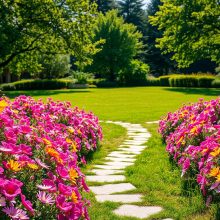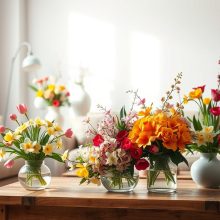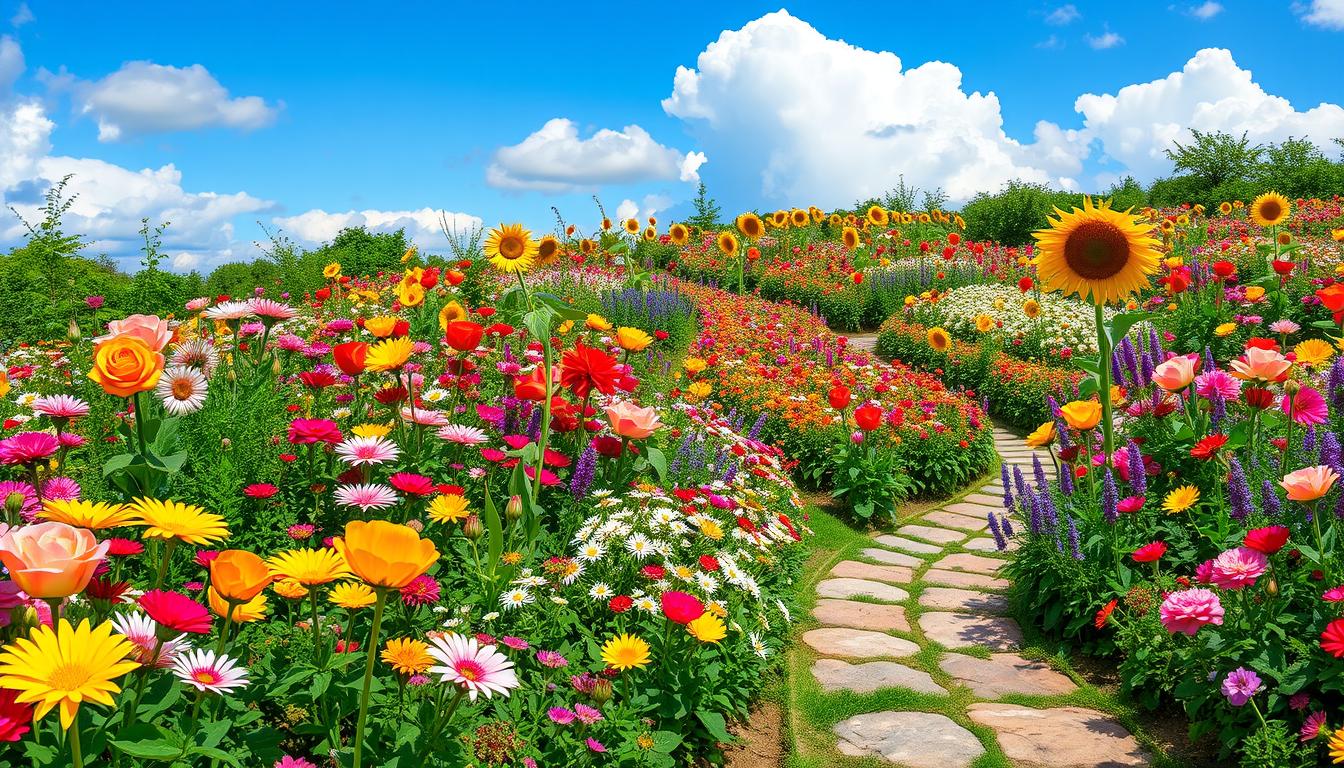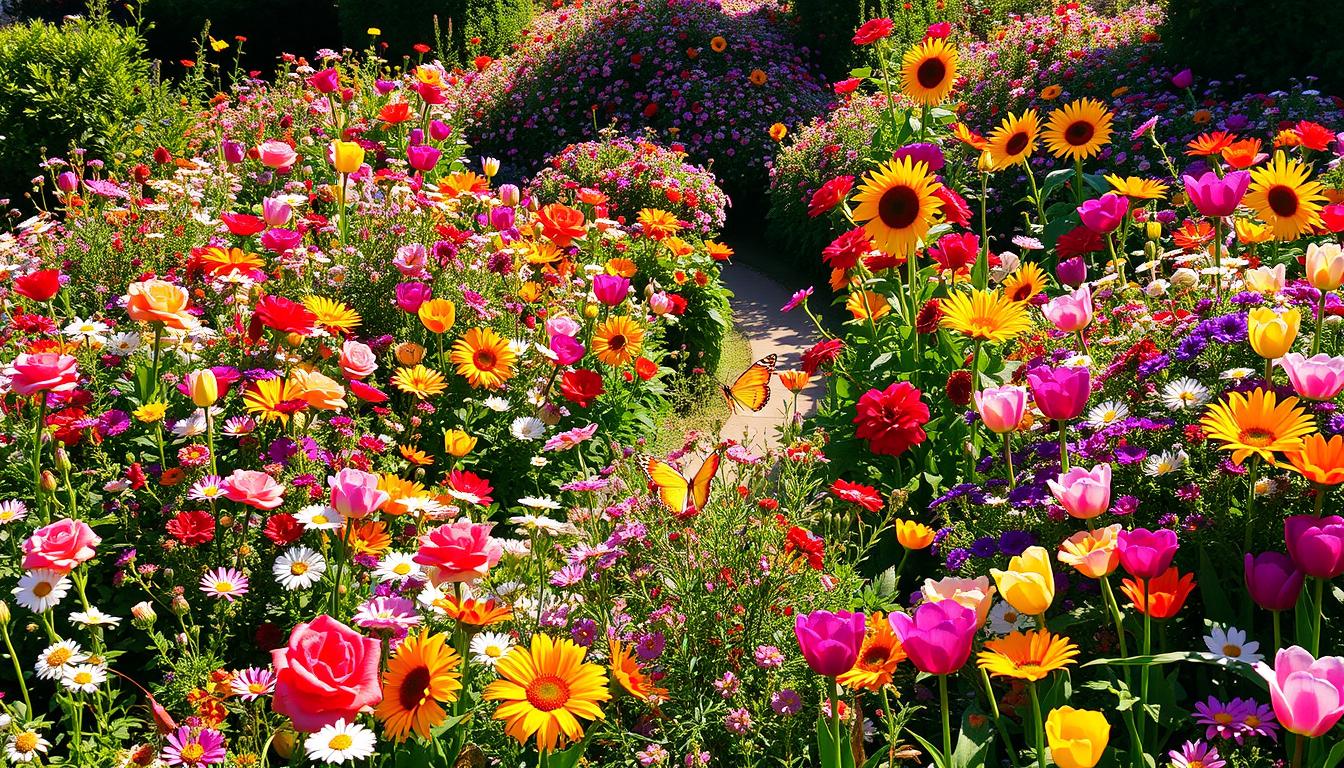Discover Popular Flower Varieties for Your Garden
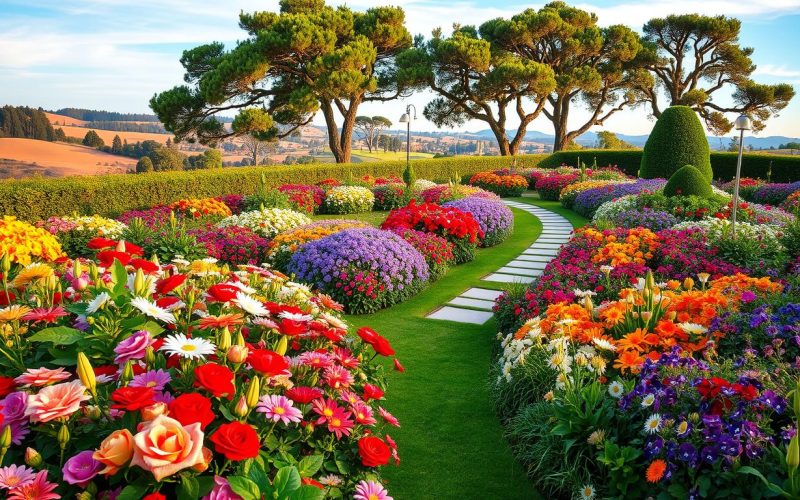
Starting a beautiful garden means picking the right flowers. Gardeners in the United States have many choices to make their yards lively. With roses and other flowers, your garden can look amazing and be good for the environment.
Choosing flowers is more than just picking colors. Each type of flower adds something special to your garden. It can make your outdoor space look incredible.
When designing your garden, think about the types of flowers you want. Consider perennials, annuals, and special flowers. Think about colors, how they grow, and how they fit with your local weather.
Key Takeaways
- Flower varieties offer diverse design possibilities
- Strategic selection enhances garden aesthetics
- Different flower types support local ecosystems
- Rose varieties provide classic garden elegance
- Consider climate and sun exposure when choosing flowers
Understanding Flower Varieties and Their Importance
Gardening fans know picking the right flowers is key. The right mix can turn a simple yard into a beautiful spot that pleases the eyes and helps nature.
Choosing different flowers is more than looks. It’s about making a garden strong and lively. Each flower type adds something special to your garden’s health and beauty.
Why Variety Matters in Gardening
Flowers are vital in garden design and keeping nature in balance. By using many flower types, gardeners get several big benefits:
- Continuous bloom throughout different seasons
- Attraction of various pollinators like bees and butterflies
- Enhanced visual interest with different heights and shapes
- Improved garden resilience against pests and diseases
The Benefits of Diverse Flower Varieties
Tulip varieties, along with others, let gardeners create amazing landscapes. Each variety adds its own colors, textures, and blooming styles. This makes your garden look even better.
By picking a variety of flowers, your garden stays lively, healthy, and beautiful all year. From small tulips to big perennials, mixing it up is essential for a great garden.
Annual vs. Perennial Flower Varieties
Gardeners can choose between annuals and perennials for their gardens. Knowing the differences between these types is key to a lively and lasting garden. Each variety has its own growth pattern and blooming cycle, making outdoor spaces vibrant.
Key Differences Between Annuals and Perennials
Annuals and perennials differ mainly in their life cycle and growth. Annuals grow, bloom, and die in one year. They start from seeds, grow fast, and then end their life cycle.
- Annuals bloom quickly and provide immediate garden color
- Perennials return each year with minimal replanting
- Annual flower varieties offer intense seasonal displays
- Perennial varieties develop stronger root systems
Popular Annual Flower Varieties
Some annuals are favorites for their bold looks in gardens. Marigolds, zinnias, and petunias are popular for their fast growth and bright colors. They keep gardens colorful all summer.
Popular Perennial Flower Varieties
Perennials, like orchids, are great for long-term gardens. Lavender, coneflowers, and black-eyed susans come back year after year. Orchids are known for their exotic beauty and special care needs.
- Lavender: Fragrant and drought-resistant
- Coneflowers: Attract pollinators
- Orchid varieties: Unique and sophisticated
Top Flower Varieties for Different Climates
Choosing the right flowers for your climate is key to a great garden. Each area has its own challenges and chances for gardeners. Knowing how weather affects plants helps pick the best flowers.
Climate greatly affects which flowers will do well in your garden. Every region has its own special conditions that affect plants. Picking the right flowers can make your garden lively and strong.
Flower Varieties for Cold Climates
Cold climate gardens need tough flowers that can handle freezing. Good choices include:
- Lily varieties like Asiatic and Oriental lilies
- Pansies
- Chrysanthemums
- Snowdrops
- Hellebores
Flower Varieties for Warm Climates
Warm climate gardens are perfect for tropical and heat-loving flowers. Try planting:
- Hibiscus
- Bougainvillea
- Lily varieties that like warm weather
- Lantana
- Zinnia
Flower Varieties for Humid Regions
Humid areas need flowers that can handle moisture and fungi. Good options are:
- Canna lilies
- Caladiums
- Impatiens
- Japanese iris
- African lily
Understanding your local climate and picking the right flowers can make a beautiful garden. Try different lily varieties and plants to find the best mix for your garden.
Flower Varieties Based on Sun Exposure
Choosing the right flowers for your garden starts with knowing the sunlight. Different flowers need different amounts of light to grow well. It’s important to check how much sun your garden gets to make it bloom beautifully.
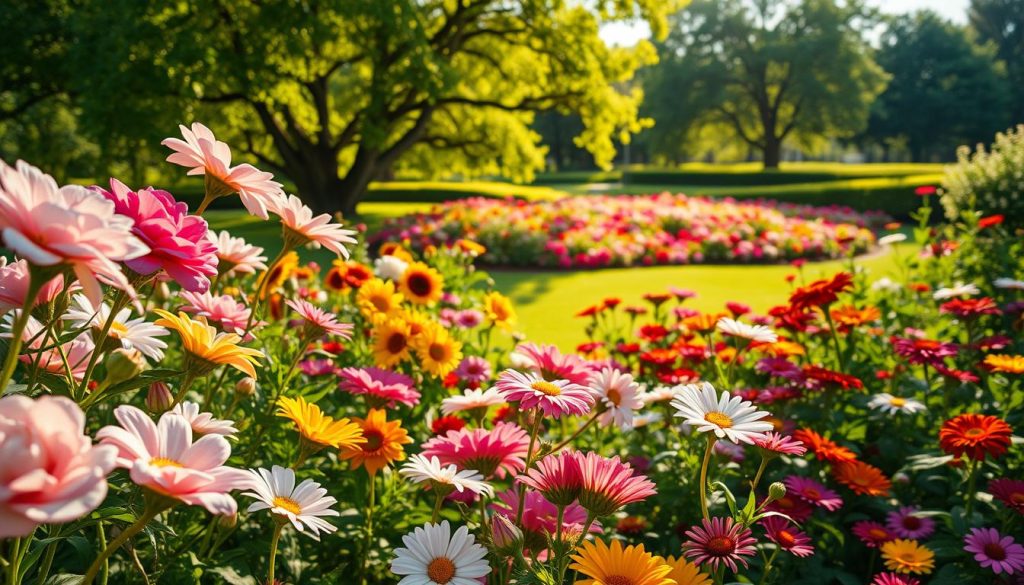
Best Flower Varieties for Full Sun
Flowers that love full sun get 6-8 hours of direct sunlight. These strong plants include:
- Sunflowers with their bright yellow petals
- Daisy varieties that love intense light
- Marigolds with vibrant orange and yellow blooms
- Lavender featuring purple flowering spikes
Shade-Loving Flower Varieties
Even with less sunlight, gardens can still be colorful. Some great choices for shade include:
- Impatiens with delicate pastel colors
- Begonias offering rich flowering displays
- Hostas featuring interesting leaf patterns
- Fuchsias with hanging bell-shaped blossoms
Partially Shaded Flower Varieties
Partial shade offers a chance for a variety of flowers. These areas get filtered sunlight or morning sun. Good choices for partial shade are:
- Delicate daisy varieties
- Columbines
- Woodland phlox
Knowing your garden’s light is key to picking the right flowers. By choosing plants that match their sun needs, gardens can be full of life and color.
Colorful Flower Varieties to Brighten Your Garden
Gardens burst with color, turning outdoor areas into lively scenes of nature. Knowing about flower varieties and their colors helps gardeners make beautiful spaces. These spaces delight the senses and improve landscape design.
Color is key in garden beauty, with each hue evoking different feelings and looks. By picking the right flowers, gardeners can make amazing outdoor spots.
Vibrant Red and Orange Flower Varieties
Red and orange flowers add excitement to gardens. They bring warmth and draw in pollinators.
- Sunflower varieties like ‘Red Sun’ offer deep crimson petals
- Scarlet zinnia provides intense red color
- Orange marigolds create brilliant summer displays
Soothing Blue and Purple Flower Varieties
Blue and purple flowers add calm and style to gardens. They bring a peaceful feel.
- Lavender offers soft purple tones
- Blue hydrangeas provide serene color variations
- Purple iris adds elegant structure
Classic White and Yellow Flower Varieties
White and yellow flowers are timeless in gardens. They brighten areas and match well with other colors.
- Classic sunflower varieties in yellow create sunny focal points
- White dahlias provide pristine, clean aesthetics
- Cream-colored roses offer subtle sophistication
Choosing flowers with different colors lets gardeners make lively, changing outdoor spaces. These spaces are full of life and beauty all season long.
Flower Varieties for Attracting Pollinators
Creating a garden that supports local wildlife is exciting. Pollinators are key to keeping ecosystems healthy and plants reproducing. By picking the right flowers, you can make your garden a vibrant home for bees, butterflies, and hummingbirds.
Bee-Friendly Flower Varieties
Bees are vital for garden health. Here are some top flowers that attract them:
- Lavender
- Echinacea (Coneflower)
- Chrysanthemum varieties with open flower structures
- Borage
- Sunflowers
Butterfly-Attracting Flower Varieties
Butterflies bring color and life to gardens. They also help with important ecological tasks. Here are some flowers that attract them:
- Milkweed
- Zinnia
- Marigolds
- Aster
- Butterfly bush
Hummingbird-Preferred Flower Varieties
Hummingbirds love flowers with tube-shaped blooms and bright colors. Here are some favorites:
- Cardinal flower
- Trumpet honeysuckle
- Bee balm
- Columbine
- Fuchsia
When choosing flowers for pollinators, pick native plants. Chrysanthemums are great if you think about pollinators. A diverse garden with many flowers supports nature and looks beautiful.
Native Flower Varieties to the United States
Native flowers are key to making gardens green and healthy in the United States. They grow well in their local areas, helping both gardens and nature. These plants are special because they fit perfectly into their environments.
Importance of Native Plants in Garden Design
Native flowers are great for gardens and animals. They need less care and water than other plants. They also help local bees and butterflies, and keep the environment balanced.
- Require minimal irrigation
- Resist local pest populations
- Support native butterfly and bee populations
- Preserve regional ecological balance
Remarkable Native Flower Varieties
The United States has many amazing native flowers for gardens. Some top picks include:
- Black-eyed Susan (Rudbeckia hirta)
- Purple Coneflower (Echinacea purpurea)
- California Poppy (Eschscholzia californica)
- Blue Lupine (Lupinus perennis)
When picking native flowers, you can also add non-native ones like peonies. Peonies add color and texture, making gardens more interesting.
By choosing native flowers, gardeners can make beautiful, eco-friendly spaces. These gardens support local wildlife and show off the beauty of American nature.
Unique Flower Varieties for Special Gardens
Garden lovers can make their outdoor areas truly special by picking unique flowers. These flowers can turn your garden into a tropical paradise or a water-saving oasis. Each choice brings a new theme and experience to your garden.
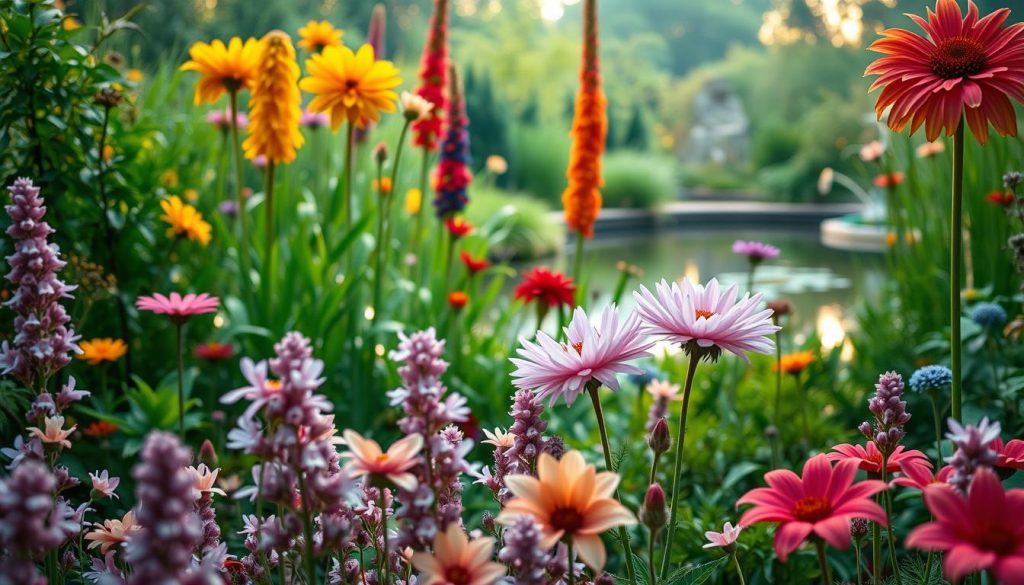
Exotic Flower Varieties for a Tropical Theme
To create a tropical garden, choose flowers that add color and texture. Here are some exotic plants for a tropical look:
- Bird of Paradise
- Hibiscus
- Plumeria
- Orchids
Drought-Resistant Flower Varieties
Water-saving gardens are becoming more popular. These flowers look great and use less water. Here are some good choices:
- Lavender
- Coneflower
- Sedum
- California Poppy
Fragrant Flower Varieties for Scented Gardens
Roses are perfect for gardens that smell as good as they look. Try Damask, English, and Bourbon roses for a fragrant garden. Add jasmine and gardenia for even more scent.
By mixing different flowers, you can make a garden that’s both beautiful and personal. It can also meet environmental needs.
Flower Varieties for Edible Gardens
Turning your garden into a tasty and pretty place is simple. Edible flowers let you mix beauty with food creativity. They add color, flavor, and health benefits to your meals.
Edible flowers open up new food adventures. While tulips aren’t usually eaten, many flowers are safe to eat. They can make your dishes more interesting.
Top Edible Flower Varieties to Grow
- Nasturtiums: Peppery flavor, bright orange and yellow blossoms
- Pansies: Mild, slightly sweet taste with delicate colors
- Violets: Subtle sweetness, perfect for desserts and salads
- Calendula: Tangy flavor, rich in health benefits
- Borage: Cucumber-like taste, beautiful blue flowers
Incorporating Flowers into Vegetable Gardens
Adding edible flowers to your veggie garden has many benefits. They make your garden look good and attract helpful bees and butterflies. For example, marigolds near tomatoes can keep pests away and add edible blooms.
When growing edible flowers, use organic gardening. Stay away from chemical pesticides. Choose natural ways to fight pests to keep your flowers safe to eat.
Flower Varieties for Container Gardening
Container gardening is great for those with little space or who want to brighten up patios and balconies. By picking the right flowers, you can turn any small area into a lovely garden spot.
Choosing the right flowers for containers is key. Each plant has its own needs. Knowing these helps your garden grow well.
Best Flower Varieties for Pots
Here are some top picks for container gardening:
- Petunias – vibrant and prolific bloomers
- Geraniums – colorful and heat-tolerant
- Begonias – shade-loving with beautiful foliage
- Orchid varieties – elegant and exotic
- Marigolds – compact and bright
Tips for Successful Container Gardening
There’s more to container gardening than picking pretty flowers. Here are some tips:
- Choose containers with proper drainage
- Use high-quality potting soil
- Match plant needs with sunlight exposure
- Water consistently
- Fertilize regularly
Orchids need special care, like the right humidity and light. Make sure to learn each plant’s needs for the best results.
Seasonal Flower Varieties to Plant Throughout the Year
To make your garden vibrant, plan with flowers that bloom in different seasons. By picking the right plants, your garden will be colorful all year long.
Creating a garden that blooms all year takes some knowledge. Choose plants that bloom at different times. This way, your garden will look great from spring to winter.
Spring Flower Varieties to Consider
Spring brings color and new life to gardens. Lilies are a highlight, with their elegant blooms in many colors. Here are some plants to consider:
- Asiatic lilies with bright, bold colors
- Tulip-like Oriental lilies
- Daffodils and early-blooming perennials
Summer Flower Varieties to Enjoy
Summer is full of sunshine and great for flowers. Pick varieties that love the heat and attract bees and butterflies:
- Sunflowers for dramatic height
- Zinnias with vibrant color ranges
- Echinacea for long-lasting blooms
Fall and Winter Flower Varieties
Keep your garden interesting in cooler months with the right flowers. Choose plants for autumn colors or ones that can handle winter:
- Chrysanthemums for autumn displays
- Hellebores for winter flowering
- Ornamental kale for texture
By mixing different flowers, your garden will be lively all year. It will show off nature’s beauty and variety.
Maintaining Your Flower Varieties
Keeping your garden healthy starts with good care. Each flower type needs special attention to grow well and look great. Knowing what your plants need helps make your garden colorful and lively.
Watering Tips for Healthy Flowers
Water is key for flowers, but they all need it differently. For example, daisies like steady moisture but don’t like too much water. Here are some tips for watering:
- Check soil moisture before watering
- Water deeply but less often
- Use mulch to keep soil moist
- Change watering based on weather and season
Fertilization Strategies for Different Varieties
Good soil is essential for strong flowers. Choose fertilizers that fit your plants’ needs. Here are some tips for fertilizing:
- Use balanced, slow-release fertilizers
- Regularly add organic compost
- Test soil pH before fertilizing
- Avoid too much fertilizer to protect roots
Pruning Techniques for Vibrant Blooms
Pruning helps flowers grow well. It’s about cutting off dead parts, improving air flow, and encouraging new growth. For daisies, a little pinch can make them fuller and flower more.
With regular care, your garden will become a beautiful showcase of nature. By following these tips, you’ll have a garden full of vibrant flowers all year round.
Resources for Flower Variety Enthusiasts
Exploring flower varieties is an exciting journey for garden lovers. Whether you love sunflowers or want to try different blooms, many resources are available. Proven Winners has a great online platform for buying top-quality flowers to make your garden pop.
Local gardening clubs are great for meeting experienced gardeners. They host workshops, plant swaps, and seminars on various flowers. Botanical gardens and nurseries also offer hands-on learning about unique flowers.
Digital platforms have changed how we share gardening info. Sites like Garden.org and Reddit’s gardening groups have lots of talks on flowers and gardening tips. Social media, like Instagram and Pinterest, has gardening groups sharing beautiful photos and tips.
For serious gardeners, books by authors like Michael Pollan and Barbara Damrosch are key. They offer deep insights into flowers, growing, and design. Apps like PlantSnap and Garden Tags help track plants and learn about different flowers in a fun way.
